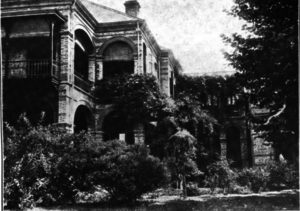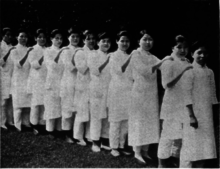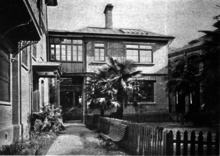Margaret Williamson Hospital

Margaret Williamson Memorial Hospital for Women and Children (婦孺醫院 1932,上海西門婦孺醫院 1937; commonly West Gate Hospital) was a missionary hospital, and the first hospital opened in Shanghai exclusively for the care of Chinese women.[1] It was located on Siccawei Road, outside the west gate of the Chinese city in the French settlement; for this reason, it was commonly known as the West Gate Hospital. The nonsectarian hospital was established in 1884 by the Woman’s Union Missionary Society.[2]
This institution admitted only Chinese women and children, with boys up to 12 years of age. No foreigners or contagious cases were taken in. There were 56,620 out-patients treated in 1914 and 1,034 in-patients, of whom 351 were obstetrical cases.[3]
Early history

The land, building, furnishing, wire-beds, instruments, and salary of a physician and nurse for seven years were all provided, at an expense of US$35,000, by Margaret Williamson, for whom the hospital was named. A maternity ward was added, at a cost of $17,000, by two sisters of Princeton, New Jersey, as well as another ward through a legacy from Dr. Wells Williams.[4] The first piece of land was secured in 1883, the year of the donor's death. Eight more pieces were later added, all lying out of the city limits. In addition to the medical buildings, there was a home for medical workers, and a house for nurses and assistants.[5]
The Women's Union Missionary Society was founded for the purpose of evangelizing local women, mainly by the founding of schools and orphanages, and in this instance, by the founding of a hospital for women. While women rarely went to Chinese hospitals, commonly only under circumstances of very great suffering, it was believed that the Margaret Williamson Hospital would be filled to overflowing.[1]
The hospital's formal opening occurred on 3 June 1884.[6] The building was a two-storied structure on the road to Sikawei, not far from the West Gate. This was the third hospital opened exclusively for women in China. The first was in Foochow by Dr. Trask, and the second in Tientsin by Dr. Howard; both were under the Methodist Episcopal Board of Missions.[6]
After the Reifsnyder-built building burned down, a new on was constructed in 1889 with funds given wholly by Chinese and foreigners in Shanghai itself. Approximately three-fourths of the support of the institution came from fees and local contributions, mostly Chinese, and one-fourth from the income of beds which are endowed in the United States. The doctors' and nurses' salaries were paid by the missionary board.[3]
In 1915, the fees charged patients were $0.15 (Mexican) dally (ibig wards); $0.50 (Mexican) daily (in semi-private wards); and $2, $4, and $5 (Mexican) daily (beds in private rooms). Those unable to pay are treated gratis, and a large proportion of the patients were of this class.[3]
1889 architecture and fittings

The hospital constructued in 1889 was made up of four brick buildings of 2.5 stories, connected by closed passageways. The first building had a clinic room, chapel, and drug room on the first floor; and on the second floor, a suite of rooms for doctor and foreign nurse, two private rooms with two beds, and one with four beds. The two operating rooms were in a second building; the clean cases being cared for in the one on the upper story and the dirty cases in the one on the lower floor. Both operating rooms were very well equipped. The third building contained the Williamson ward on the second floor, with 17 beds, and the Wells Williams ward on the lower floor, with 29 beds. Besides these there are two semiprivate wards, one containing 6 beds and the other 4 beds, and one private room with 2 beds. The fourth building was the Stevens Maternity Hospital, containing two well-equipped delivery rooms, one for clean cases and another for septic ones—35 beds for clean deliveries and 7 for septic ones.[3]
The floors were covered with Ningpo varnish, and were scrubbed twice daily. The maternity ward was steam heated, and the other buildings supplied with stoves. The institution was lighted by electricity, and furnished with running hot and cold water. The buildings had no elevators, and the hospital was supplied with one kitchen.[3]
Grounds
The hospital was located on Siccawei Road, outside the west gate of the Chinese city in the French settlement; for this reason, it was commonly known as the West Gate Hospital. The Pont Ste. Catherine and railway station street car line passed the place about 2 miles (3.2 km) out from the French Bund. Owing to its proximity to canals holding stagnant water, the hospital grounds were infested with mosquitoes. The back of the buildings had some pleasant grounds, with grass, shrubbery, and trees.[3]
Notable people
Not much was known about Williamson. She lived in New York, was not rich, but was a Christian philanthropist. Having heard a great deal of the lack of readiness of Chinese women to take advantage of the means they possessed of obtaining medical assistance, she devoted a generous sum to form a fund for the establishment of a hospital for Chinese women, to be built under the Woman's Union Missionary Society, of which Society she was one of the founders.[1]
Rev. Bishop Boone presided at the hospital's opening, and addresses were made by Dr. Alexander Jamieson and Rev. A. J. Bamford. The institution was initially under the superintendence of Miss M. A. Burnett; the physician was Dr. Elizabeth Reifsnyder; the head nurse was Miss Elizabeth McKechnie. The Committee consisted of Reifsnyder (Secretary); Miss Burnett (Treasurer); and Mrs. Hughes, Mrs. Wetmore, Mrs. Low, and Dr. Jamieson; while the visiting physician was Dr. H. W. Boone.[6]
By 1915, the medical staff consisted of four doctors—Dr. Reifsnyder, Dr. M. Emily Garner, Dr. Mary E. Newell, and Dr. Julia N. Wood. The nursing staff consisted of Miss Bethra Miller, an American graduate nurse, in charge of 20 Chinese women in training.[3]
References
 This article incorporates text from a work in the public domain: B. J. Allen's A Crusade of Compassion for the Healing of the Nations: A Study of Medical Missions for Women and Children (1919)
This article incorporates text from a work in the public domain: B. J. Allen's A Crusade of Compassion for the Healing of the Nations: A Study of Medical Missions for Women and Children (1919) This article incorporates text from a work in the public domain: American Presbyterian Mission's The Chinese Recorder and Missionary Journal (1885)
This article incorporates text from a work in the public domain: American Presbyterian Mission's The Chinese Recorder and Missionary Journal (1885) This article incorporates text from a work in the public domain: J. Davy's The collected works of Sir Humphry Davy ...: Discourses delivered before the Royal society. Elements of agricultural chemistry, pt. I (1891)
This article incorporates text from a work in the public domain: J. Davy's The collected works of Sir Humphry Davy ...: Discourses delivered before the Royal society. Elements of agricultural chemistry, pt. I (1891) This article incorporates text from a work in the public domain: A. Foster's Christian Progress in China: Gleanings from the Writings and Speeches of Many Workers (1889)
This article incorporates text from a work in the public domain: A. Foster's Christian Progress in China: Gleanings from the Writings and Speeches of Many Workers (1889)
- 1 2 3 Foster 1889, p. 191.
- ↑ "Margaret Williamson Hospital". Indiana University-Purdue University Indianapolis. Retrieved 21 May 2016.
- ↑ Davy 1891, p. 485.
- ↑ Allen 1919, p. 104.
- 1 2 3 American Presbyterian Mission 1885, p. 237.
Bibliography
- Allen, Belle Jane (1919). A Crusade of Compassion for the Healing of the Nations: A Study of Medical Missions for Women and Children (Public domain ed.). Central committee on the united study of foreign missions.
- American Presbyterian Mission (1885). The Chinese Recorder and Missionary Journal (Public domain ed.). American Presbyterian Mission Press.
- Davy, John (1891). The collected works of Sir Humphry Davy ...: Discourses delivered before the Royal society. Elements of agricultural chemistry, pt. I (Public domain ed.). Smith, Elder and Company.
- Foster, Arnold (1889). Christian Progress in China: Gleanings from the Writings and Speeches of Many Workers (Public domain ed.). Religious Tract Society.
- United States Navy (1915). United States Naval Medical Bulletin (Public domain ed.). U.S. Government Printing Office.